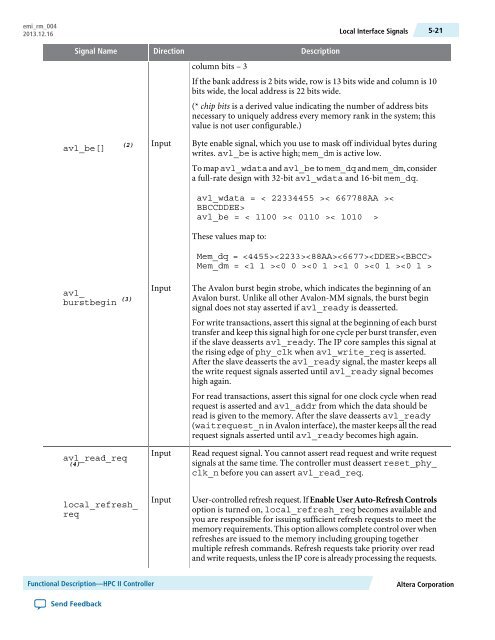Functional Description -- HPC II Controller, External Memory ... - Altera
Functional Description -- HPC II Controller, External Memory ... - Altera
Functional Description -- HPC II Controller, External Memory ... - Altera
Create successful ePaper yourself
Turn your PDF publications into a flip-book with our unique Google optimized e-Paper software.
emi_rm_004<br />
2013.12.16<br />
Local Interface Signals<br />
5-21<br />
Signal Name<br />
Direction<br />
<strong>Description</strong><br />
column bits – 3<br />
If the bank address is 2 bits wide, row is 13 bits wide and column is 10<br />
bits wide, the local address is 22 bits wide.<br />
(* chip bits is a derived value indicating the number of address bits<br />
necessary to uniquely address every memory rank in the system; this<br />
value is not user configurable.)<br />
avl_be[]<br />
(2)<br />
Input<br />
Byte enable signal, which you use to mask off individual bytes during<br />
writes. avl_be is active high; mem_dm is active low.<br />
To map avl_wdata and avl_be to mem_dq and mem_dm, consider<br />
a full-rate design with 32-bit avl_wdata and 16-bit mem_dq.<br />
avl_wdata = < 22334455 >< 667788AA ><<br />
BBCCDDEE><br />
avl_be = < 1100 >< 0110 >< 1010 ><br />
These values map to:<br />
Mem_dq = <br />
Mem_dm = <br />
avl_<br />
burstbegin (3)<br />
avl_read_req<br />
(4)<br />
Input<br />
Input<br />
The Avalon burst begin strobe, which indicates the beginning of an<br />
Avalon burst. Unlike all other Avalon-MM signals, the burst begin<br />
signal does not stay asserted if avl_ready is deasserted.<br />
For write transactions, assert this signal at the beginning of each burst<br />
transfer and keep this signal high for one cycle per burst transfer, even<br />
if the slave deasserts avl_ready. The IP core samples this signal at<br />
the rising edge of phy_clk when avl_write_req is asserted.<br />
After the slave deasserts the avl_ready signal, the master keeps all<br />
the write request signals asserted until avl_ready signal becomes<br />
high again.<br />
For read transactions, assert this signal for one clock cycle when read<br />
request is asserted and avl_addr from which the data should be<br />
read is given to the memory. After the slave deasserts avl_ready<br />
(waitrequest_n in Avalon interface), the master keeps all the read<br />
request signals asserted until avl_ready becomes high again.<br />
Read request signal. You cannot assert read request and write request<br />
signals at the same time. The controller must deassert reset_phy_<br />
clk_n before you can assert avl_read_req.<br />
local_refresh_<br />
req<br />
Input<br />
User-controlled refresh request. If Enable User Auto-Refresh Controls<br />
option is turned on, local_refresh_req becomes available and<br />
you are responsible for issuing sufficient refresh requests to meet the<br />
memory requirements. This option allows complete control over when<br />
refreshes are issued to the memory including grouping together<br />
multiple refresh commands. Refresh requests take priority over read<br />
and write requests, unless the IP core is already processing the requests.<br />
<strong>Functional</strong> <strong>Description</strong>—<strong>HPC</strong> <strong>II</strong> <strong>Controller</strong><br />
<strong>Altera</strong> Corporation<br />
Send Feedback
















